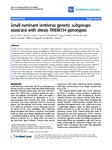Por favor, use este identificador para citar o enlazar este ítem:
http://www.alice.cnptia.embrapa.br/alice/handle/doc/971944| Título: | Small ruminant lentivirus genetic subgroups associate with sheep TMEM154 genotypes. |
| Autor: | SIDER, L. H.  HEATON, M. P.   CHITKO-McKOWN, C. G.   HARHAY, G. P.   SMITH, T. P. L.   LEYMASTER, K. A.   LAEGREID, W. W.   CLAWSON, M. L.   |
| Afiliación: | LUCIA HELENA SIDER, CNPC; Michael P. Heaton, United States Department of Agriculture (USDA). Agricultural Research Service (ARS), U.S. Meat Animal Research Center (USMARC), State Spur 18D, Clay Center, NE 68933, USA.; Carol G Chitko-McKown, United States Department of Agriculture (USDA) Agricultural Research Service (ARS), U.S. Meat Animal Research Center (USMARC), State Spur 18D, Clay Center, NE 68933, USA.; Greg P. Harhay, United States Department of Agriculture (USDA) Agricultural Research Service (ARS), U.S. Meat Animal Research Center (USMARC), State Spur 18D, Clay Center, NE 68933, USA.; Timothy P. L. Smith, United States Department of Agriculture (USDA). Agricultural Research Service (ARS), U.S. Meat Animal Research Center (USMARC), State Spur 18D, Clay Center, NE 68933, USA.; Kreg A. Leymaster, 1United States Department of Agriculture (USDA) Agricultural Research Service (ARS), U.S. Meat Animal Research Center (USMARC), State Spur 18D, Clay Center, NE 68933, USA.; William W. Laegreid, Department of Veterinary Sciences, University of Wyoming, 1174 Snowy Range Road, Laramie, WY 82070, USA.; Michael L. Clawson, United States Department of Agriculture (USDA). Agricultural Research Service (ARS), U.S. Meat Animal Research Center (USMARC), State Spur 18D, Clay Center, NE 68933, USA. |
| Año: | 2013 |
| Referencia: | Veterinary Research, v. 44, p. 64, Jul. 2013. |
| Descripción: | Abstract: Small ruminant lentiviruses (SRLVs) are prevalent in North American sheep and a major cause of production losses for the U.S. sheep industry. Sheep susceptibility to SRLV infection is influenced by genetic variation within the ovine transmembrane 154 gene (TMEM154). Animals with either of two distinct TMEM154 haplotypes that both encode glutamate at position 35 of the protein (E35) are at greater risk of SRLV infection than those homozygous with a lysine (K35) haplotype. Prior to this study, it was unknown if TMEM154 associations with infection are influenced by SRLV genetic subgroups. Accordingly, our goals were to characterize SRLVs naturally infecting sheep from a diverse U.S. Midwestern flock and test them for associations with TMEM154 E35K genotypes. Two regions of the SRLV genome were targeted for proviral amplification, cloning, sequence analysis, and association testing with TMEM154 E35K genotypes: gag and the transmembrane region of env. Independent analyses of gag and env sequences showed that they clustered in two subgroups (1 and 2), they were distinct from SRLV subtypes originating from Europe, and that subgroup 1 associated with hemizygous and homozygous TMEM154 K35 genotypes and subgroup 2 with hemi- and homozygous E35 genotypes (gag p < 0.001, env p = 0.01). These results indicate that SRLVs in the U.S. have adapted to infect sheep with specific TMEM154 E35K genotypes. Consequently, both host and SRLV genotypes affect the relative risk of SRLV infection in sheep. |
| Thesagro: | Ovino Doença animal Genética animal Virus Virologia Filogenia |
| NAL Thesaurus: | Sheep Lentivirus Small ruminants Genotyping Virology Phylogeny |
| Palabras clave: | TMEM154 SRLV Genotipagem Animal genetic Diseases Genotypes |
| DOI: | 10.1186/1297-9716-44-64 |
| Tipo de Material: | Artigo de periódico |
| Acceso: | openAccess |
| Aparece en las colecciones: | Artigo em periódico indexado (CNPC)  |
Ficheros en este ítem:
| Fichero | Descripción | Tamaño | Formato | |
|---|---|---|---|---|
| apiSmallruminantlentivirus.pdf | 1.22 MB | Adobe PDF |  Visualizar/Abrir |









